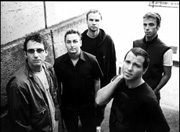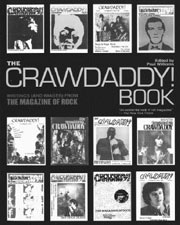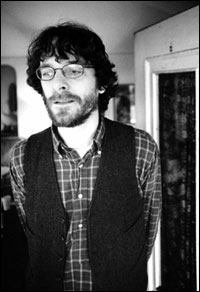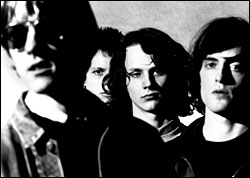Where were you in ’92? If you’re from Seattle, of course, it’s a ridiculous question; everyone knows what was going on back then. Leave the inquiry to nosy outsiders—like me. Now, I’ve never set foot in Seattle. In fact, the closest I’ve ever gotten to your city was a darkened movie theater, watching Cameron Crowe’s Singles, or maybe that awful hankie wringer with Tom Hanks and Meg Ryan in it. But in 1992, around the time that Pearl Jam’s debut, Ten, was picking up serious momentum en route to landing at No. 2 on the Billboard charts exactly one year after its Oct. ’91 release, I was working in a Tucson, Ariz., record store. And I got to witness the impact the group’s massive success—along with Nirvana’s and Soundgarden’s ascents and the arrival of the so-called “Seattle Sound”—had upon the national music consciousness.
Nowadays, the mental image of what we at the store used to disparagingly refer to as “the baby grunge brigades”—all kitted out in regulation Vedder flannels, below-knee baggy shorts, and black Docs or army boots—may seem a tad quaint. But even after malls had replaced thrift stores for one-stop grunge gear shopping, I sensed that whatever these kids were feeling, it was every bit as valid and real for them as when I underwent my own consciousness shift back in the late ’60s. This was the first genuine, fully formed underground-to-mainstream phenomenon to grip the collective teenage American imagination since the days of Woodstock—I felt the tingle of d骠 vu. That, and the visceral, sonic whomp of Ten, a classic by any standard.
Cut to 2000: Nov. 6, backstage at KeyArena. Pearl Jam has just played the final show of the Binaural tour. For band members Eddie Vedder, Stone Gossard, Mike McCready, Jeff Ament, and Matt Cameron, teeth-gritting relief mingles with bone-deep exhaustion. It’s not the usual end-of-tour vibe. For the band, it’s more like an era has come to an end, both figuratively (the Oct. 22 show in Las Vegas had marked the 10th anniversary of their first gig) and literally: Roskilde, June 30 in Copenhagen, where people got hurt, people died, and some in the international press tried to blame Pearl Jam for the tragedy.
Vedder recalls the group’s darkest moment, saying, “The days following [Roskilde], we were all pretty inconsolable. I’m sure that the families and friends have had to live with it in much rougher ways than us. But our own personal experience was that we were practically in the fetal position over the reality of what had happened. Pete and Roger from the Who both called, and the one question I asked Pete was, ‘What does this mean karmically? Why did it happen to us, since it seems we had worked so hard to maintain safety for the people who came?’ Because it’s always been safety first and respect for the people who come to see us. And he actually turned it around: ‘It might have happened to you because you could handle it.'”
Not everybody was confident they could survive the tragedy, however.
“When we still weren’t sure what had happened or how it went down, I think we all thought at the time, ‘This could be it,'” observes longtime band manager Kelly Curtis. “We came back home [from Europe], and after a month or so passed, we realized we hadn’t even gotten to say goodbye to the crew and all that. So the night before the tour was to resume in America, we had this big dinner for everybody that was there in Roskilde. A lot of people I hadn’t seen since then. And I think it really re-bonded everybody in a way. Even the audiences were really respectful, like they understood. The first couple of shows were really scary for the guys. But they came together, and I think the audiences had a lot to do with that. Did I think there was a chance [of splitting up]? I probably felt that way more right after Roskilde. But still. . . . ” Curtis’ voice trails off for a second, then he quickly adds, “You know, this band has been through a lot together.”
“I WAS THINKING about U2,” says guitarist McCready, “how they did a huge amount of press for their last record, and how if we could do even one-tenth of what they did, it would be beneficial for us—to get back into the public eye a little bit. I don’t think as a band we would ever say [as U2 did], ‘We want to be the world’s greatest rock ‘n’ roll band.’ But we want to be a really good band. It’s also because we feel pretty great about the record, too. We’re excited to talk about it. And this time we decided to do a lot,” he adds, laughing, “by our standards!”
McCready is explaining Pearl Jam’s newfound accessibility to the press. While doing a week of interviews in Seattle with international journalists and another week in New York with the American press corps doesn’t have quite the same razzamatazz as, say, Bruce Springsteen’s nonstop media blitz this past summer, compared to prior PJ album kickoffs, this was fairly unprecedented.
Agreeing with McCready, bassist Ament adds, “The guys in U2, they would tell us, ‘C’mon, you guys gotta get back on the wave with us, take rock ‘n’ roll back. . . . ‘ I don’t know if we feel the same thing, feel that responsible to all of music to be that. But the climate of things right now makes it a good time to communicate with people—although I think we feel more of a responsibility to ourselves to play good music . . . [to] that big communal ball of energy between you and your crowd.”
Still, expectations for Pearl Jam’s seventh studio album, Riot Act, are high. Not counting the, um, 72 live albums and concert DVD, it’s their first recorded artifact in two years. Guitarist Stone Gossard observes: “[When] we’re really psyched about a record, that gives you impetus to go, ‘OK, we can do press.’ Even though in general, by not doing a ton of press and by sticking to our guns as a band, I think we’ve managed to gain a little bit more respect from some people that might not have cared as much about us otherwise. We’ve learned how to balance everything out now in terms of how much you live in the press world and how much time you live making music with your friends. And a bit more about what your personal priorities are. That helps a lot.”
PERSONAL PRIORITIES occupied much of 2001-02 for the members of Pearl Jam. Vedder did so much surfing out in the Pacific that he became an honorary resident of Hawaii, additionally doing numerous ukulele-wielding solo gigs and frequently appearing onstage with New Zealand popster Neil Finn. McCready’s own side project, the Rockfords, toured. He also worked on the Vanilla Sky soundtrack with Heart’s Nancy Wilson. Gossard did a solo record, Bayleaf, toured and recorded an album with Brad, and played bass on Mudhoney’s Steve Turner’s upcoming solo album. Drummer Cameron spent a lot of time doing session work (most notably with Nickelback’s Chad Kroeger on the Spider-man theme song “Hero”) and toured with Wellwater Conspiracy. And while Ament’s Three Fish has been somewhat invisible of late, the bassist recently recorded with Kings X’s Doug Pinnick.
So when, this past February, it came time to begin rehearsing new band material, everyone’s vacations had cleansed their musical palates. Sessions with Adam Kasper producing (Soundgarden, Foo Fighters, Queens of the Stone Age) went quickly. As Cameron observes, “I think we came into this thing pretty prepared and focused in terms of what we wanted to do. Adam is a super guy, and that helped a lot—the working environment was really relaxed. We tore through it, tracked everything in about four weeks. You’re really hearing it ‘live,’ the sound of a band playing together in a room—which you don’t hear too much these days.”
Indeed, Riot Act is unbelievably fluid and wide-screen in terms of composition, charged and focused thematically. Aside from Pearl Jam embracing a truly democratic approach to songwriting (something that had been slowly creeping into the group dynamic over the past two albums), the presence of keyboardist Kenneth “Boom” Gaspar, whom Vedder met while in Hawaii, helped give the sessions a fresh twist. The tunes themselves are simultaneously the group’s most diverse—moody, Beatles-esque pop one minute, effects-heavy psychedelic funk the next, deep pools of blue-eyed soul the next—and the most classic sounding since the Ten and Vs. days.
From Vedder and Gossard’s dark, edgy political satire “Bush Leaguer” to Ament’s brawny, old-school blues-rocker “1/2 Full” to Vedder’s Who- styled “I Am Mine” existential anthem, the album feels at times uncannily like 1992 all over again. And despite recurring lyrical images of losing, dying, and wrestling with personal turmoil, the album ultimately comes across as triumphant and defiant, not moody or flailing.
“Part of being comfortable as an artist is allowing yourself to experience those moments of transcendence, of some of the pain in the world,” muses Gossard. “So you do have significant feelings of loss and pain and going through the death of friends and family. Those tend to be powerful images that come up when you’re trying to write about things that are strong or powerful. So yes, there are some heavy words, and yes, I do find the record pretty defiant in a lot of ways: ‘I Am Mine,’ ‘Can’t Keep’—those songs are kind of about looking death in the face and saying, ‘I’m not going to be afraid of you!'”
Adds Vedder, “I think, to be honest, when the music comes out of us, it’s really just to satisfy ourselves in a way, you know? And if there are messages of light at the end of the tunnel in there, it almost might be to remind [the band] of it later. We write something hopeful at a time when we’re feeling hopeful, so we can be reminded of it at those times we’re less hopeful. I mean, having to sing it in front of people, it actually kind of reminds you of your own . . . philosophies—something you came up with on a good day and you’re reminded of it.”
THREE DECADES AGO, the Woodstock Nation’s explosion of hormones, hirsute fashion stylings, and status-quo-challenging music was fueled in large part by a media eager to exploit a marketable youth culture. And its arguable that—superior levels of songwriting talent, musical huevos, and band-audience chemistry notwithstanding—had it not been for the Hubble-sized lens the media pointed at them, Pearl Jam’s ascent might not have taken them so high or so far.
From the Oct. 31, 1991, issue of Rolling Stone, written by journalist (and future Pearl Jam biographer) Kim Neely: “The songs on Ten explore the magnificent profundity of everyday reality; they ring with an earthiness and mysticism that convey a dazzling array of emotions. . . . Despite their often sad subject matter, they are oddly celebratory. Ten is the sort of album that makes you want to stand on a mountain and yell.”
Hyperbolic, yes; inaccurate, no; useful as a sales tool, certainly. Yet if you believe the folks in Pearl Jam, it’s never been about hype, marketing, or chart positions. This is probably a good stance to take, since according to numbers recently cited by USA Today, Pearl Jam’s sales figures have generally declined with each album: 8.9 million copies of Ten moved off the shelves; 1993’s Vs. sold 5.8 million; 1994’s Vitalogy, 4.6 million; 1996’s No Code, 1.4 million; 1998’s Yield held steady at 1.5 million; then with Binaural, a nosedive to 714,000.
Armchair cynics aware that Pearl Jam’s Epic Records contract expires with Riot Act might ask whether or not the band’s got a lot riding on it, given how in the current music biz climate, a position of bargaining strength derives almost exclusively from one’s latest SoundScan tally.
According to manager Curtis, though, the long-term goal simply involves survival. Hopefully, with lives, friendships, and integrity still intact.
“When a band gets really successful, I don’t know what the percentages are, but I bet if you go and look at history, just to survive success is a really hard thing,” says Curtis. “You’ve got people who are struggling, living together, eking out demos—and all of a sudden you have to start talking about lawyers and contracts and publishing splits. Money, some people spend that in ways that can harm them. Egos get involved. Well, to get successful is hard enough. To make it over that hump is even harder, a whole other thing. When you do that, it’s a real lucky thing. We managed to do that.
“And I think—with people’s attention spans, all that—as much as we alienated fans by not doing videos or a lot of press and TV, it probably helped the band stay around, too. And we could have done it, man, all the TV commercials, all the endorsements, all that stuff and gone for the dough. But they said no to all that. . . . And [regarding] our record company, we’ve never even been after the big advance and all that. Just more control and ownership of our masters. If [upcoming contract talks] work out, there’s no reason why we wouldn’t end up staying with Sony.”
Riot Act hits stores next week, and with the exception of getting ready for back-to-back appearances on The Late Show With David Letterman (Nov. 14 and 15), Pearl Jam seem remarkably uninterested in the album’s trajectory. They’re proud of the music they recorded, and they dutifully followed up with their press rounds (they also shot a video for “I Am Mine” back in September at Chop Suey, with James Frost directing). It’s out of their hands now, anyway. There’s a big charity benefit concert coming up on Dec. 8 at KeyArena, but the Riot Act tour doesn’t start until next spring. Time to relax for a couple of months.
And besides, at the end of the day, these are all just details. Thinking back to my record-store days and remembering those kids in flannel, shorts, and boots for whom music—and Pearl Jam’s in particular—was such an integral, essential part of their lives, I wonder if for the guys in Pearl Jam there was a parallel experience that suggests the nature of the glue that has held them together.
Recalling a period several years ago when he had begun to feel overwhelmed, not only by the expectations of fans but the pressure placed upon him as Pearl Jam’s chief lyricist, Vedder admits that things can become daunting. “All of a sudden it loses its spark and it is not fun anymore. If you’re in a band, and you get to make records, and it’s not fun, then there’s gotta be a way to get that back,” he says.
“So now people come in with complete ideas, lyrics, complete songs, we just stick ’em all in the collective pot, and there’s more than enough to go around and maintain a certain level. Trusting each other’s tastes, I think, is good. And instincts, too. Instincts in how they approach a part. Because once you turn [a song] over to the group, you have to kind of let it go. It’s learning how not to be abject at change,” he adds, laughing. “That, and we change drummers every four years!”
“All of us are music fans who love to play music,” agrees Gossard. “I think everyone in this band is engaged with life; we’re all moving at our own tempo, yet at the same time, we’re all actively living. Nobody is sitting at home spending long hours in front of the TV. So I think as a human being, if you just remain fresh in your long-term commitment to each other—like, ‘this is home, this is what I like to go back to, this feels good’—by having that in your head, when you do come back, you’re energized to make music and it comes naturally. The sanity and happiness within this band is palpable—just the respect and feeling of security the band provides. Everyone is aware of that.”
“If there’s a time when we come back and everybody’s bored and not into it, maybe you try it a couple more times, and then if it doesn’t feel right, well, maybe it’ll be time to give it a rest,” says Ament. “But the last three records, for me, it doesn’t feel so much like pulling teeth as it used to, when maybe we weren’t communicating very well, no one expressing what they wanted or what their needs were. Having gone through that and getting to a point where we can talk to one another without it turning into a big fight or a big drama, well, that’s a treat. That’s the good part about being grown up.
“And you know what? Right now the Stones, the Who, Neil Young, Bob Dylan—they’re all rewriting the rules of rock ‘n’ roll,” he enthuses. “You can do it for a long time, and you can do it the right way. You can do it with honesty.”









